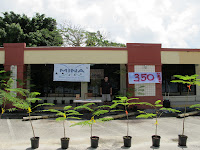It is the beginning of October, and now it's time to say goodbye to a fellow Micronesia Challenge intern. I Kid Cabrera have worked along side Dave as partners throughout our internship. It has been a great learning experience working with Dave in various outreach activities and events. Having a partner to work with makes everything seem easier and more enjoyable. From presenting at American Memorial Park about how to lessen our need for plastic bags to going to High schools and Dinner parties presenting our internship experiences, Dave has been a great partner and a cool one as you can see in the pic to your right. I hope that the next batch of Champions will have partners to work with as well so that the internship experience can be a better one. The internship Dave and I are a part of has bought us closer together as friends and one day we might work alongside each other once again to help bring the importance of our earth and its precious valuable resources to the community and the world!









































